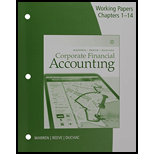
Concept explainers
Accrued Expenses
Accrued expense refers to the expenses those are unpaid, but the goods and services related to the payment are received in a particular accounting period. These accrued expenses are payable for the business. Business treats accrued expenses as a liability.
Adjusting entries indicates those entries, which are passed in the books of accounts at the end of one accounting period. These entries are passed in the books of accounts as per the revenue recognition principle and the expenses recognition principle to adjust the revenue, and the expenses of a business in the period of their occurrence.
Rule of Debit and Credit:
Debit - Increase in all assets, expenses & dividends, and decrease in all liabilities and
Credit - Increase in all liabilities and stockholders’ equity, and decrease in all assets & expenses.
To record: The adjusting entry for the accrued salary for the period ending on Wednesday and Thursday.
Want to see the full answer?
Check out a sample textbook solution
Chapter 3 Solutions
Working Papers for Warren/Reeve/Duchac's Corporate Financial Accounting, 14th
- Lawrence Industries plans to produce 30,000 units next period at a denominator activity of 45,000 direct labor hours. The direct labor wage rate is $16.00 per hour. The company's standards allow 2.2 yards of direct materials for each unit of product; the material costs $8.50 per yard. The company's budget includes a variable manufacturing overhead cost of $3.25 per direct labor hour and fixed manufacturing overhead of $270,000 per period. Using 45,000 direct labor hours as the denominator activity, compute the predetermined overhead rate and break it down into variable and fixed elements.arrow_forwardCan you show me the correct approach to solve this financial accounting problem using suitable standards?arrow_forwardCould you explain the steps for solving this general accounting question accurately?arrow_forward
- Please explain the solution to this general accounting problem with accurate principles.arrow_forwardWhat is the company's CM ratio?arrow_forwardJohnson Jewelry uses the perpetual inventory system. On May 12, Johnson sold merchandise for $95,000 to a customer on account with terms 2/10, n/30. The cost of goods sold (COGS) was $37,000. On May 20, Johnson received payment from the customer. Calculate the amount of gross profit.arrow_forward
- Can you help me solve this general accounting question using valid accounting techniques?arrow_forwardLauren's Hardware common stock is currently selling at $48.75 per share. The company follows a 55% dividend payout ratio and has a P/E ratio of 18. There are 75,000 shares of stock outstanding. What is the amount of the annual net income for the firm? solve this Accounting problemarrow_forwardPlease provide the correct answer to this financial accounting problem using valid calculations.arrow_forward
 Cornerstones of Financial AccountingAccountingISBN:9781337690881Author:Jay Rich, Jeff JonesPublisher:Cengage Learning
Cornerstones of Financial AccountingAccountingISBN:9781337690881Author:Jay Rich, Jeff JonesPublisher:Cengage Learning College Accounting (Book Only): A Career ApproachAccountingISBN:9781337280570Author:Scott, Cathy J.Publisher:South-Western College Pub
College Accounting (Book Only): A Career ApproachAccountingISBN:9781337280570Author:Scott, Cathy J.Publisher:South-Western College Pub College Accounting (Book Only): A Career ApproachAccountingISBN:9781305084087Author:Cathy J. ScottPublisher:Cengage Learning
College Accounting (Book Only): A Career ApproachAccountingISBN:9781305084087Author:Cathy J. ScottPublisher:Cengage Learning College Accounting, Chapters 1-27AccountingISBN:9781337794756Author:HEINTZ, James A.Publisher:Cengage Learning,Principles of Accounting Volume 1AccountingISBN:9781947172685Author:OpenStaxPublisher:OpenStax College
College Accounting, Chapters 1-27AccountingISBN:9781337794756Author:HEINTZ, James A.Publisher:Cengage Learning,Principles of Accounting Volume 1AccountingISBN:9781947172685Author:OpenStaxPublisher:OpenStax College College Accounting, Chapters 1-27 (New in Account...AccountingISBN:9781305666160Author:James A. Heintz, Robert W. ParryPublisher:Cengage Learning
College Accounting, Chapters 1-27 (New in Account...AccountingISBN:9781305666160Author:James A. Heintz, Robert W. ParryPublisher:Cengage Learning





